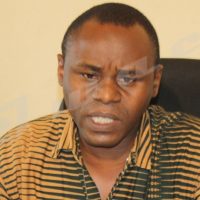Internet users keep asking questions about the progress of the establishment of the National Optical Fiber network implemented within the Communication Infrastructure Project (PIC). They wish to benefit from its advantages both in terms of reliability and service costs. The Executive Secretary of ICT Secretariat answers some questions.
Pierre Ndamama, SETIC Executive Secretary “…there must be sensitization on the use of Information and Communication Technologies at all levels.” ©Iwacu“For the last five years, people have been talking about an optic fiber network project, what is the current state of the project?” Claver Nikobandi wonders. He is co-owner of a Cyber Café in downtown Bujumbura. He adds that he has lost customers because of the bad internet access quality in his center.
A similar concern for Teddy Iradukunda, who operates in the same business in Mutanga Sud: “To add to the bad internet access, I still charge the same rate per minute (BIF15) as before.”
S.N., Secretary in one of the travel agencies, has difficulties sending professional e-mails to her partners who are out of the country. When she chats with her friends on skype, Twitter or Facebook, she often looses internet connection.
Within the Communication Infrastructure Project (PIC) financed by the World Bank, a transport network, that covers the entire territory, has been established, according to Pierre Ndamama, Executive Secretary for Burundi Information and Communication Technologies Executive Secretariat (SETIC). “The network offers great capacity and performance and is more reliable than networks that use other technologies. Unfortunately, the network is running at less than 10%.of its capacity”
Need of ICT democratization
Pierre Ndamama mentions that since September 2013, prices on communication services have been reduced to some extent, but not to the expectations of the users as yet. The Burundi Backbone System Company (BBS) which established and operates the network is buying International capacity from foreign suppliers and is reselling it to local operators. These later are in charge of providing access and related services to their subscribers. “The more bandwidth demand BBS gets, the lower unit prices they will get and therefore the higher connection speed the end-users will get for less money,” explains the Executive Secretary of the ICT Secretariat .
According to him, there must be sensitization campaign on the use of communication and information technologies at all levels. The main objective, he states, is to generate more local content and hence more traffic information. However, Ndamama underlines the main gaps in this ICT democratization: a low purchasing power, illiteracy, the lack of infrastructure, outdated access networks and a limited number of ICT terminals using internet (computers, smart phones, tablets).
“The recurring and endless electricity shortage problem must be addressed and power cuts limited, in order to guaranty ICT services access availability and continuity. Otherwise, the users won’t get the benefit expected from the deployment of BBS on a regular, continuous and durable basis,” he points out.
The Executive Secretary indicates that all 17 provinces are connected the National Backbone made of a 1254 Km Optic Fiber network. He adds that 50 public institutions are already connected via a government communication system known as COMGOV which is providing them Internet Services.
“Moreover, all the local Mobile Operators and Internet Service Providers are already the BBS network and distributing BBS supplied capacity,” he concludes Pierre Ndamama.


















 IWACU Open Data
IWACU Open Data

